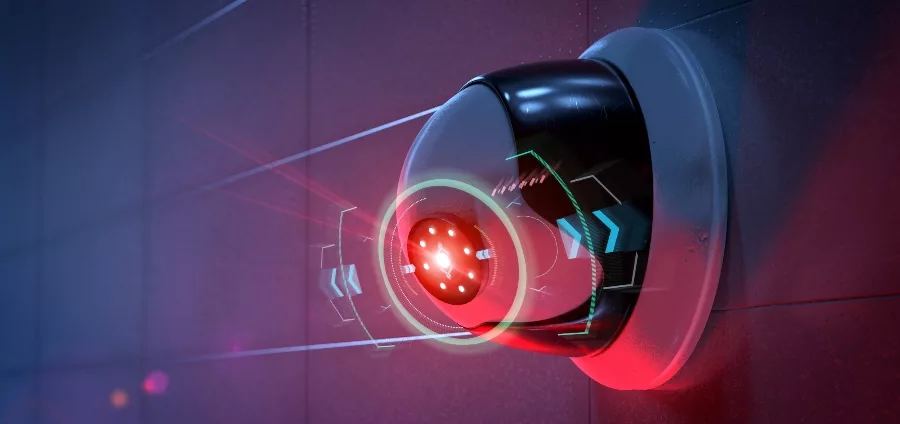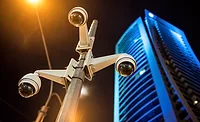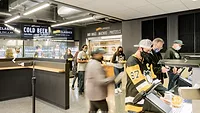4 uses for smart cameras in fast-casual restaurants

There have been few paradigm and culture shifts in the US that have had a lasting impact, quite like the rise of fast-food restaurants. Both fueling and encouraging an on-the-go lifestyle, the transformation of food consumption began in 1921 with America’s first fast food burger joint – White Castle. This new type of dining seemed to appeal to a fast-paced way of life – offering convenience and affordability, and requiring a new assembly line production style which was the first of its kind. White Castle wouldn’t be alone for long. Kentucky Fried Chicken (KFC) would open in 1930, McDonald’s in 1940, and Burger King and Taco Bell would join by the mid-1950s. Franchises of these brands appeared across the United States, despite economic struggles and global unrest.
Many major fast-food chains, such as McDonald’s, Burger King, KFC, Chick-fil-A, etc., operate sophisticated systems to ensure safety and security in restaurants 24/7. This sets a standard for security hardware and equipment in all locations. These include video surveillance systems, alarm systems, time-delay safes, fortified drive-thru windows and robbery prevention training for the entire staff. Additionally, the rate of production in today’s fast-casual restaurants requires operations to be conducted at a volume and pace too rapid for humans to consistently monitor and execute in a productive manner.
Today’s technology has evolved from “digital” to “smart,” leveraging Artificial Intelligence (AI) to gain better insights into business operations and understand customer behavior. An example of this shift are some recent acquisitions in the fast-casual and quick-service industry, including McDonalds’ $300 million acquisition of Dynamic Yield, an experience optimization platform with the goal of providing franchises with data-driven “decision logic” technology.
One method fast-casual chains can use to simplify the automation and optimization of foodservice operations is by employing Artificial Intelligence (AI) as part of a video surveillance system. Smart security cameras combine the Internet of Things (IoT) and security cameras with AI analytics, helping operators automate monitoring and analyzing visitor and employee behavior. By gaining valuable insights from video data, restaurant operations can be optimized, and customer experience will be enhanced.
Video analytics for consistency and optimal production execution
Optimized execution and consistent quality are barriers faced by many fast-casual food chains, and when coupled with rising labor costs, low training and high employee turnover, they are making the case for technology solutions designed to help with consistent execution. However, very few are taking advantage of digitized, or automated, opportunities. According to the Zenput, 2020 Restaurant Ops Report, 27% of operators say their company is embracing technology to automate various aspects of their organization “to a great extent.” However, for 83% of operators who have embraced automation, they report their experience has been positive.
Because uniformity of the customer experience is an important aspect of fast-casual spaces, it’s important each location streamline the entire process from customer line entry to ordering, production and delivery and exit. Smart cameras equipped with AI-video analytics are also helping food retailers to ensure consistency across locations and processes in a variety of innovative ways.
One restaurant that was able to increase sales based on business intelligence gathered from smart cameras was Happy Donazz & Co, a German baked goods chain specializing in American style donuts. With 15 franchise outlets occupying a mix of locations, including in shopping centers and some inside major food retailers, the German chain needed a consistent way to analyze the performance of individual outlets. This information would be used to create internal benchmarks for corporate and franchisee use as well as to provide individual franchise owners intelligence to make improvements and boost individual store sales.
Enhanced store layout and restaurant flow
Smart cameras equipped with AI video analytics enable operations staff to continuously monitor visitor traffic in restaurants. Happy Donazz was able to utilize a footfall application in its stores to monitor customer flow. By gathering visual analysis overtime, Happy Donazz was able to detect and respond to customer flow patterns.
Through the use of heat mapping applications, a geographical representation of the data can be gained from camera systems, enabling operators to easily identify critical areas and take appropriate action to optimize layout. For example, if a restaurant offers a self-checkout or online order pick-up station, smart cameras can help decision-makers in designing the best possible routes through a restaurant for customers.
Over time, analysis can also help identify weaknesses in restaurant layout and improve overall customer experience. By offering real-time insights, cameras can also help to spot loitering in the restroom or identify suspicious behavior in corners or hallways that are difficult to monitor. The cameras can also monitor the self-checkout or online order pick-up areas for suspicious behavior and possible thefts.
Optimized staff schedule and management
Proper staffing for busy times can be difficult for many fast-casual restaurants. Smart cameras can help fine-tune and optimize personnel planning by analyzing restaurant occupancy continuously. This ensures managers can keep enough staff on hand at all times, creating superior customer experiences. Smart security cameras detect visitors entering and leaving a restaurant, using people counting applications, and analyze restaurant occupancy over time – enabling managers to plan staffing based on actual demand, rather than just assumption.
Leverage video applications to increase sales conversions
Smart cameras can analyze foot traffic along the point of sale (POS) in fast-casual restaurants, offering vital insight into busy hours. This data can show if a restaurant is closing too early and losing sales, or not closing early enough and losing money. By simply adjusting opening and closing hours with existing visitor flows, daily sales can be increased significantly. By utilizing these smart cameras, Happy Donazz was able to make proper scheduling and operational changes with relative ease, as they had data to reinforce their decision-making.
The future of video analytics in fast-casual restaurants
Today, fast-casual restaurants are as popular as ever, both with consumers looking for a quick bite and consistent brand experience, as well as with entrepreneurs seeking a solid franchise investment. While fast-casual restaurants have been required to adapt to modern technologies faster than other restaurants – due to the speed and accuracy requirements of production, this offers them the unique opportunity to be some of the first to leverage video analytic technology. By doing so, fast-food and fast-casual restaurants can ensure quality standards are being met and that each store is running as optimally as possible, while offering the guest a consistent experience.
This article originally ran in Security, a twice-monthly security-focused eNewsletter for security end users, brought to you by Security Magazine. Subscribe here.
Looking for a reprint of this article?
From high-res PDFs to custom plaques, order your copy today!







